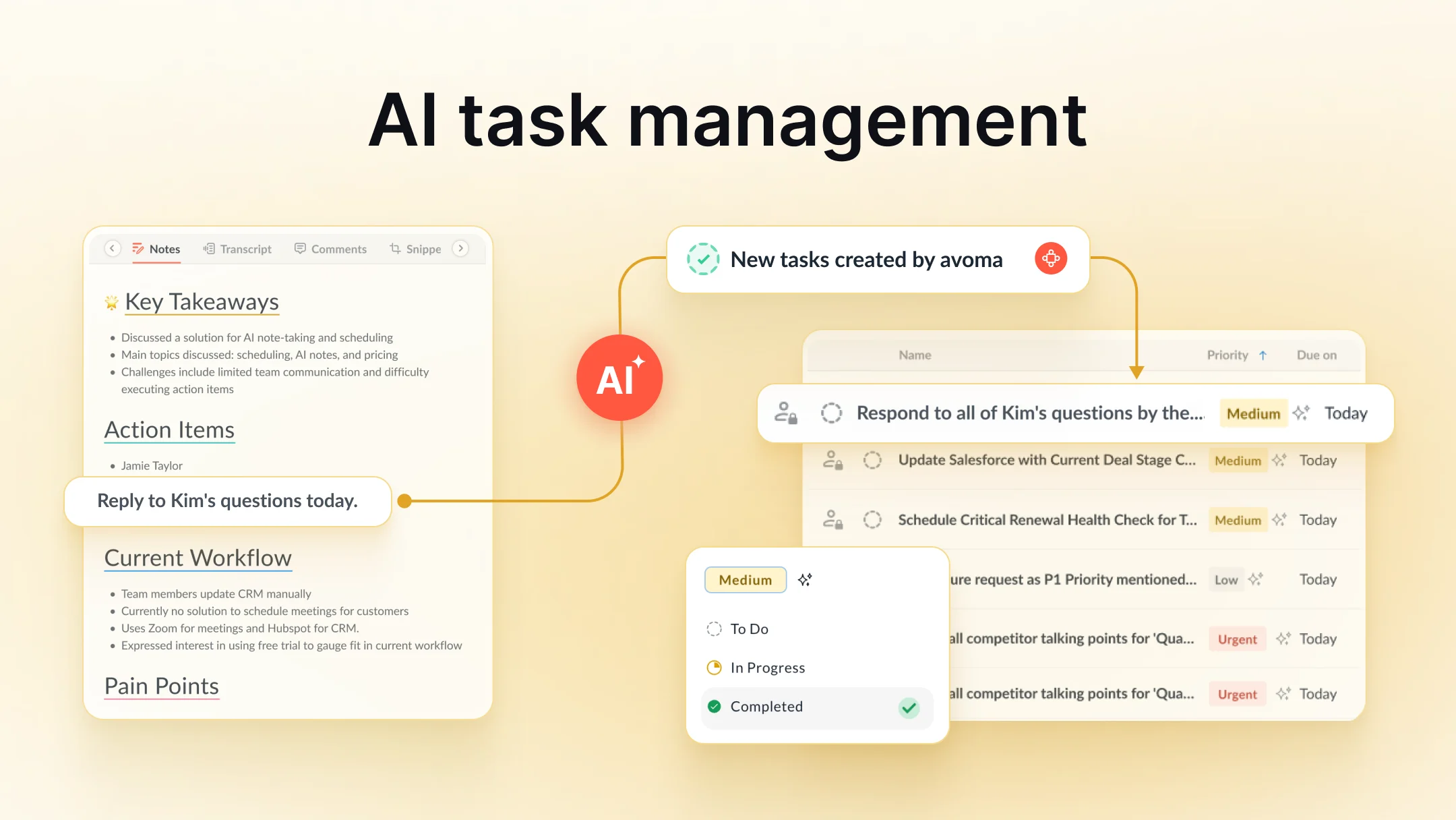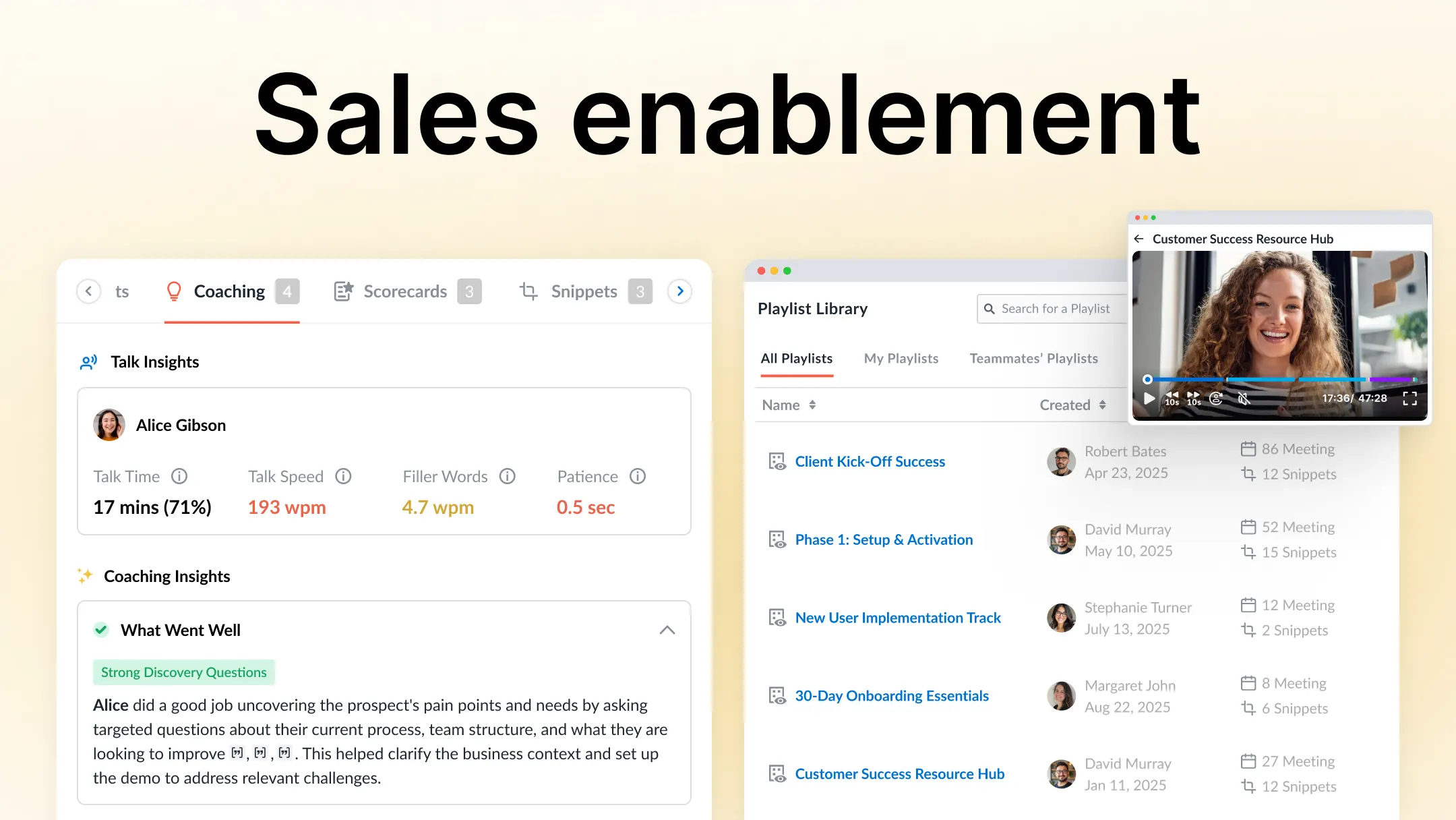How do marketing teams use Conversation Intelligence software
Table of Contents:
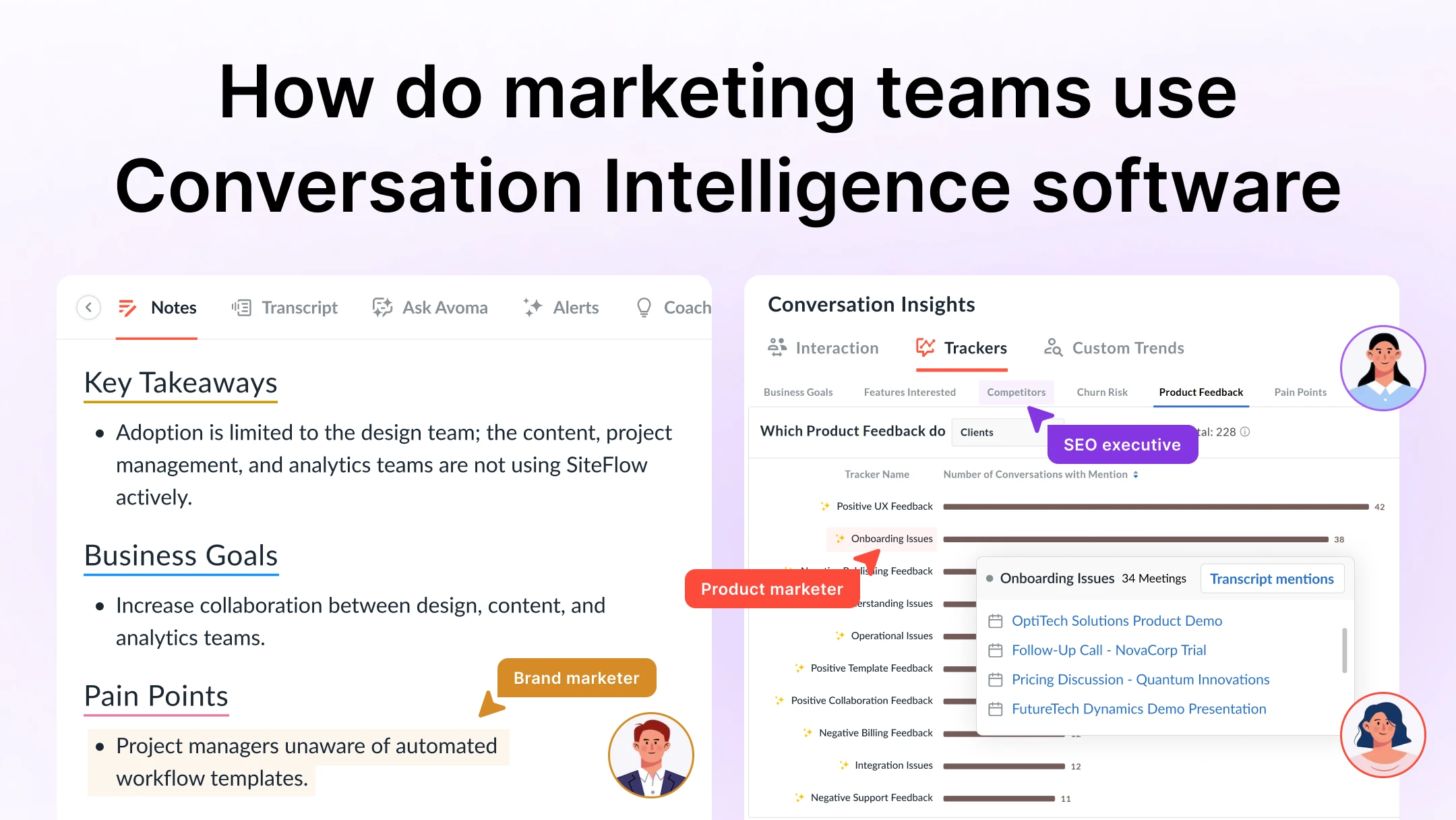
You're probably drowning in data. Dashboard after dashboard. Survey results. Website analytics. Maybe quarterly NPS scores.
But if you’re in marketing, you know that data only tells part of the story.
What it doesn’t capture is the real voice of your customers: what they actually say when they talk to your sales team, your CS reps, your product folks.
Those are the conversations where prospects describe their pain points in their own words, share why they took your demo, and reveal what almost made them walk away.
That’s where conversation intelligence finally gives marketing teams a seat at the customer conversation.
What is conversation intelligence for marketing?
Conversation intelligence for marketing means capturing and analyzing real customer and prospect conversations right from sales calls to onboarding meetings. It uncovers patterns, trends, and insights you won’t find in dashboards or surveys. It helps marketers understand how people talk about their problems, what messaging resonates, and which objections come up most often. In short, it turns raw conversations into data that fuels smarter positioning, sharper content, and better go-to-market alignment.
How does conversation intelligence help marketing teams?
Conversation intelligence platforms like Avoma automatically record, transcribe, and summarize conversations across your organization. They surface key topics, track competitor mentions, and highlight recurring themes, giving marketing teams instant access to unfiltered customer insights.
Avoma turns meetings, calls, and demos into structured customer insights across Product Marketing, Content, Demand Gen, and Leadership.
Marketing teams using conversation intelligence experience:
- GTM messaging validation in 1-2 weeks vs 2-3 months
- Better content production cycle aligned with pain points
- 3-4 hours saved weekly per marketer through automated meeting notes and searchable recordings
- Stronger alignment with Sales, Customer Success, and Product
What this guide covers
Most marketing teams barely scratch the surface and that’s what this guide is here to fix.
You’ll learn how to turn recorded calls into content ideas, SEO keywords your prospects actually use, messaging that connects, and case studies you can create in days instead of weeks.
Quick wins you can implement today with Avoma
- For product marketers: Search for your top competitor's name. See what prospects say when AEs bring them up. Add customer snippets to a playlist called “Why We Switched.” Use those insights to update your battle cards.
- For content marketers: Set up a Smart Tracker to capture phrases like “we used to use” or “before [your product]”. You’ll automatically collect quotes about what customers used before your product. Use them for customer-centric storytelling across your blogs, newsletters, and campaigns.
- Another option for content: You can Ask Avoma to “summarize multiple conversations around feature ‘X’ or topic. You’ll see what questions keep coming up and what people truly care about, perfect input for blog outlines, pillar pages, or topic clusters.
- For demand gen: Pull up calls from high-value accounts. Identify the pain points they mention most (or the competitors that come up in close-lost deals). Use those insights to build hyper-targeted ad campaigns and sharpen landing page messaging.
- For social managers: Ask Avoma to surface moments of positive sentiment from customer calls. Grab the best quotes about [your product] and share them on LinkedIn to build trust and spark engagement.
Let’s go deeper in how each part of your marketing organization can turn conversations into measurable impact.
1. Product marketing: Use real customer voice to sharpen your messaging
You probably spend weeks crafting new positioning. Run it by leadership. Then you launch it across the site, update all the decks, brief the sales team. Then you wait. Eight weeks later, conversion's flat. Was it the message? The timing? You have no idea.
Story:
Alex, a Director of Product Marketing at a B2B SaaS company, struggled with inconsistent messaging between Sales and Marketing. Every week, AEs shared conflicting feedback on what resonated with prospects.
By using Avoma’s Conversation Insights Dashboard, Alex began reviewing snippets of prospect calls.
With Smart Topics (which automatically categorizes conversations by themes like pricing, competitors, or product fit), Alex quickly identified which messaging points were landing – and which were confusing the prospects.
Use Cases:
- Win–Loss Analysis: Analyze patterns from closed–won vs. closed–lost calls to refine messaging and sales enablement content.
- Voice of Customer Reports: Use Keyword Tracking to identify recurring phrases customers use when describing pain points or value, ensuring content speaks in their language.
- Case Study Creation: Pull quotes, results, and testimonials directly from recorded calls to create credible, customer-backed stories.
ROI:
- PMMs report 30% faster message testing cycles
- 25% improvement in win–loss accuracy after listening to real buyer conversations
“I love that I can listen to the voice of our customers and/or prospective customers every single day. As a customer marketer, I need to always keep a pulse on the general sentiment and then tailor my messaging to that”, Tyler J explains. “Within 15 mins or so I can listen to a full call and feel more connected to our market. SO valuable!”
“Avoma’s automatic transcriptions have saved me at least 10 hours a week, and 2 hours per case study without paying for different transcription tools. I can now create case studies and deliver them within 1-2 days. It’s a total game-changer for me.” - Matt, Director of Demand Gen @ Directus
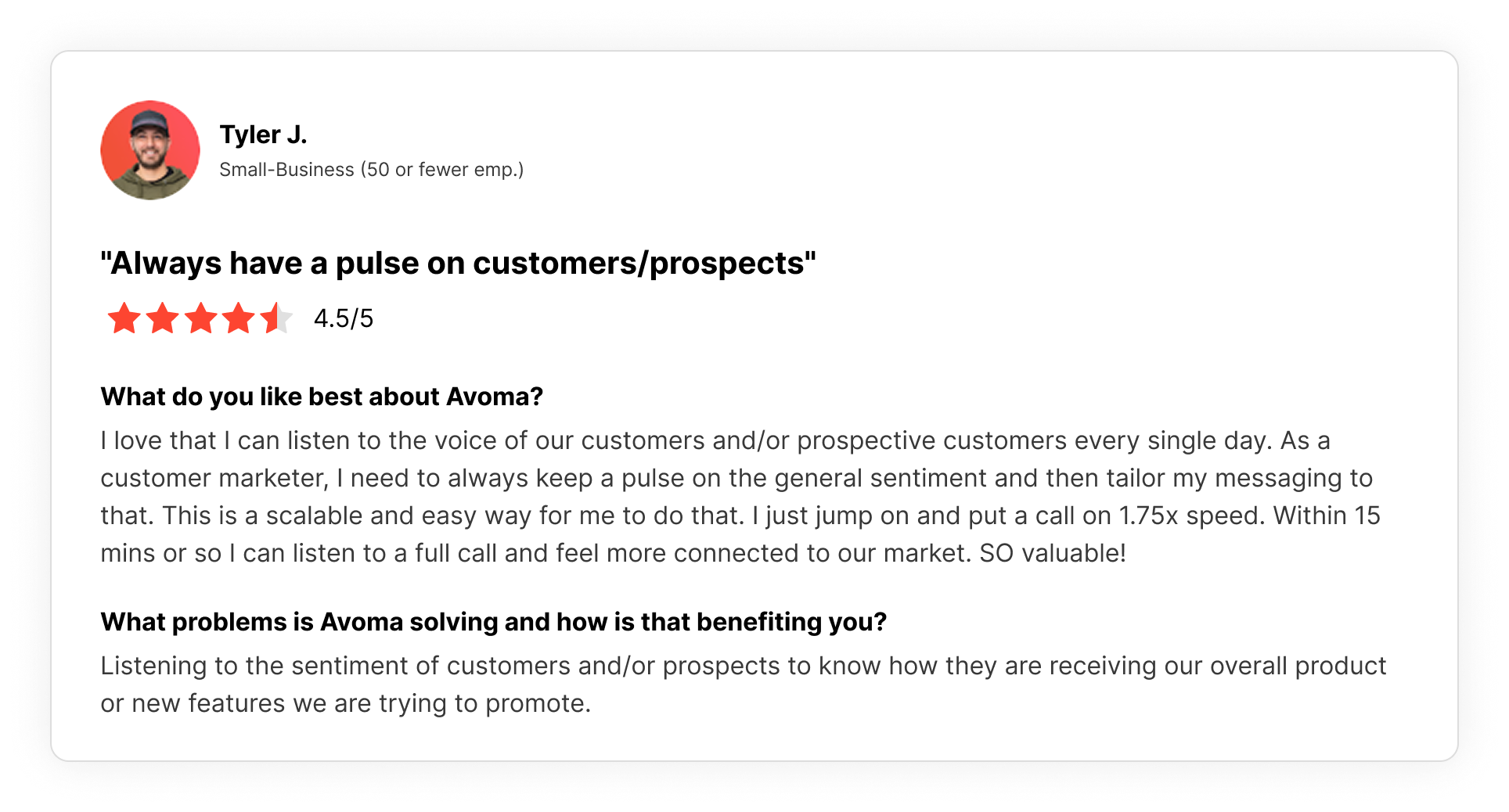
2. Content marketing: Turn conversations into compelling stories
You're writing about customer problems you probably don't actually live with. You're trying to tell authentic stories without direct access to the customer. You end up relying on sales to relay what prospects say, or you're interpreting survey responses, or you're just... guessing at the language real people use.
Story:
Priya, a Content Marketing Manager, used to depend on secondhand input from sales and CS teams for customer stories. With Avoma, she started searching call transcripts using AI Notes and Global Search to find real customer quotes describing value in their own words.
Those quotes became the backbone of authentic case studies, blog content, landing page copies, and social snippets.
Use Cases:
- Content Ideation: Use Topic Detection to see emerging trends and recurring pain points across customer calls.
- Quote Mining: Use Snippets – short, shareable video or audio clips – in blog posts or social campaigns.
- Editorial Collaboration: Share timestamped call moments directly with writers or video editors for faster content creation.
ROI:
- Teams save 4–6 hours weekly on note-taking and summarization.
- 40% faster content creation cycles by reusing customer language and clips.
Nicki puts it best, “It allows our marketing team to have insight into the problems our leads are facing as they describe them inside sales calls, which allows us to craft content that speaks to those points and is valuable to them.”
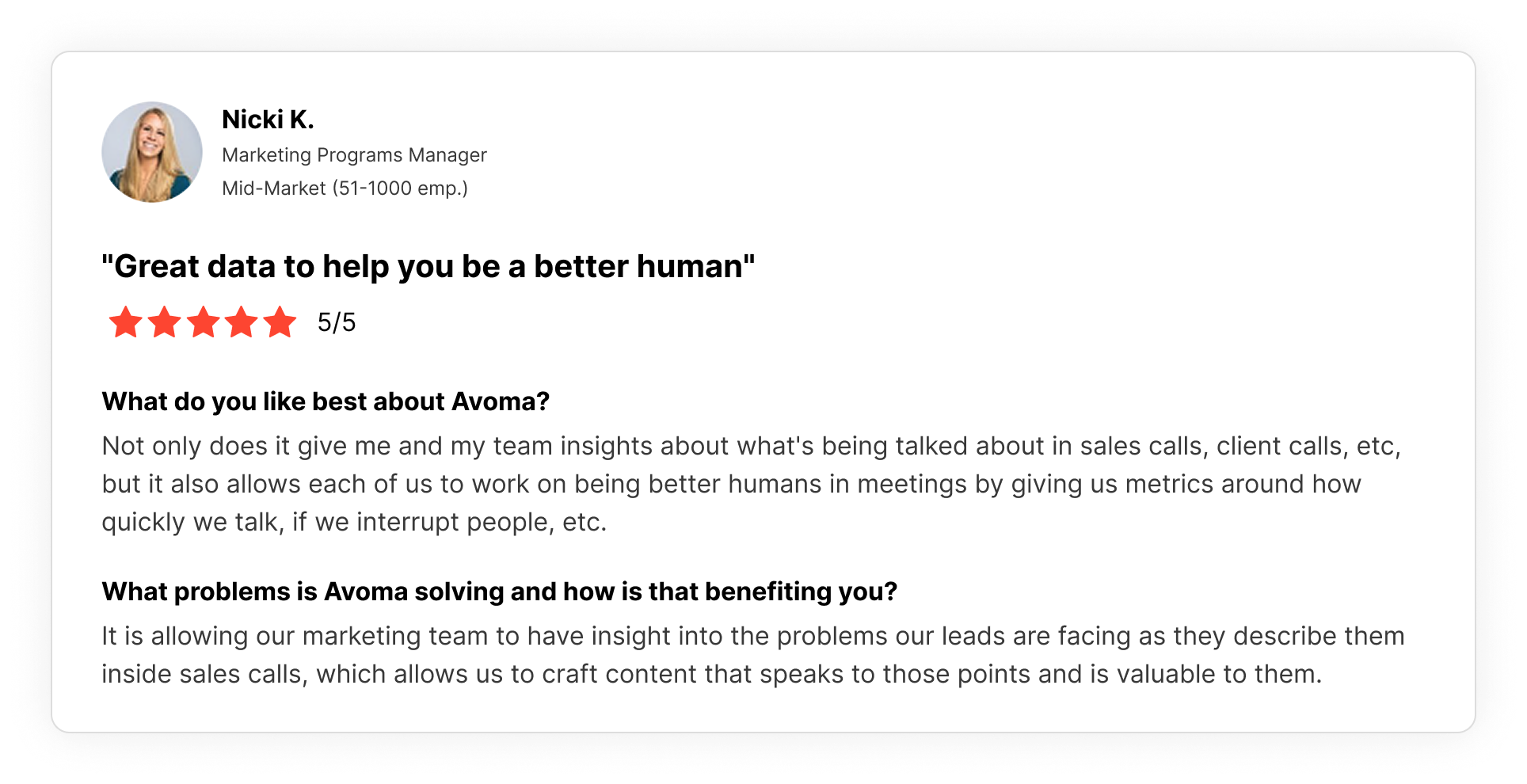
3. SEO & Demand Gen: Let customers write your keywords and campaigns
You know what's better than keyword research tools? Listening to real conversations with your prospects and tracking what language prospects actually use.
Story:
Dylan, a Demand Gen Manager, noticed landing page performance had gone flat. When he looked at Avoma insights, he realized prospects kept describing their top challenge differently than he had framed it. Example - “no visibility into calls” instead of “disorganized meeting notes.”
He adjusted ad copy, blog titles, and keyword strategy – and saw a 28% lift in click-through rates the next quarter.
Use Cases:
- Topic Discovery: Use Keyword or Smart Trackers to find natural language phrases your audience uses and incorporate them in your copies.
- Campaign Optimization: Monitor how prospects react to new offers or messaging during calls to identify top-performing hooks.
- Persona Insights: Identify differences in how decision-makers and users describe challenges, helping refine targeting.
ROI:
- Teams report 20–30% better campaign resonance by aligning ad and content copy with real customer language.
Martin, Growth Marketer, listens to calls to understand the impact of his campaigns. “With Avoma I can see the specific demos that the marketing team generated and determine the quality of the leads.”

4. Social & brand: Create authentic stories at scale
You post consistently. You try different formats. You're constantly hunting for content ideas that'll actually resonate, and you're never quite sure what'll land until after you hit publish. Some posts pop, most don't.
Story:
Rachel, a Social Media Manager, was searching for easy-to-share content on social platforms like YouTube and LinkedIn. With Avoma’s Playlist Library, she saves clips of 20–30 second customer highlights and leadership POV on key topics directly from recorded calls.
Use Cases:
- Customer Advocacy: Turn real moments into short-form video or testimonial clips.
- Thought Leadership: Share insights from internal Avoma call snippets to highlight company and leadership expertise.
- Campaign Amplification: Create themed social posts around emerging customer trends found in Topic Reports.
ROI:
- Teams see 2-4X engagement on social posts using authentic customer moments.
“Avoma is helping me understand the voice of the customer faster so I can present back social proof for brand strategy work I do for clients. Plus, it quickly helps craft customer testimonials used on our website and social marketing channels.” - Bennett, Managing Partner
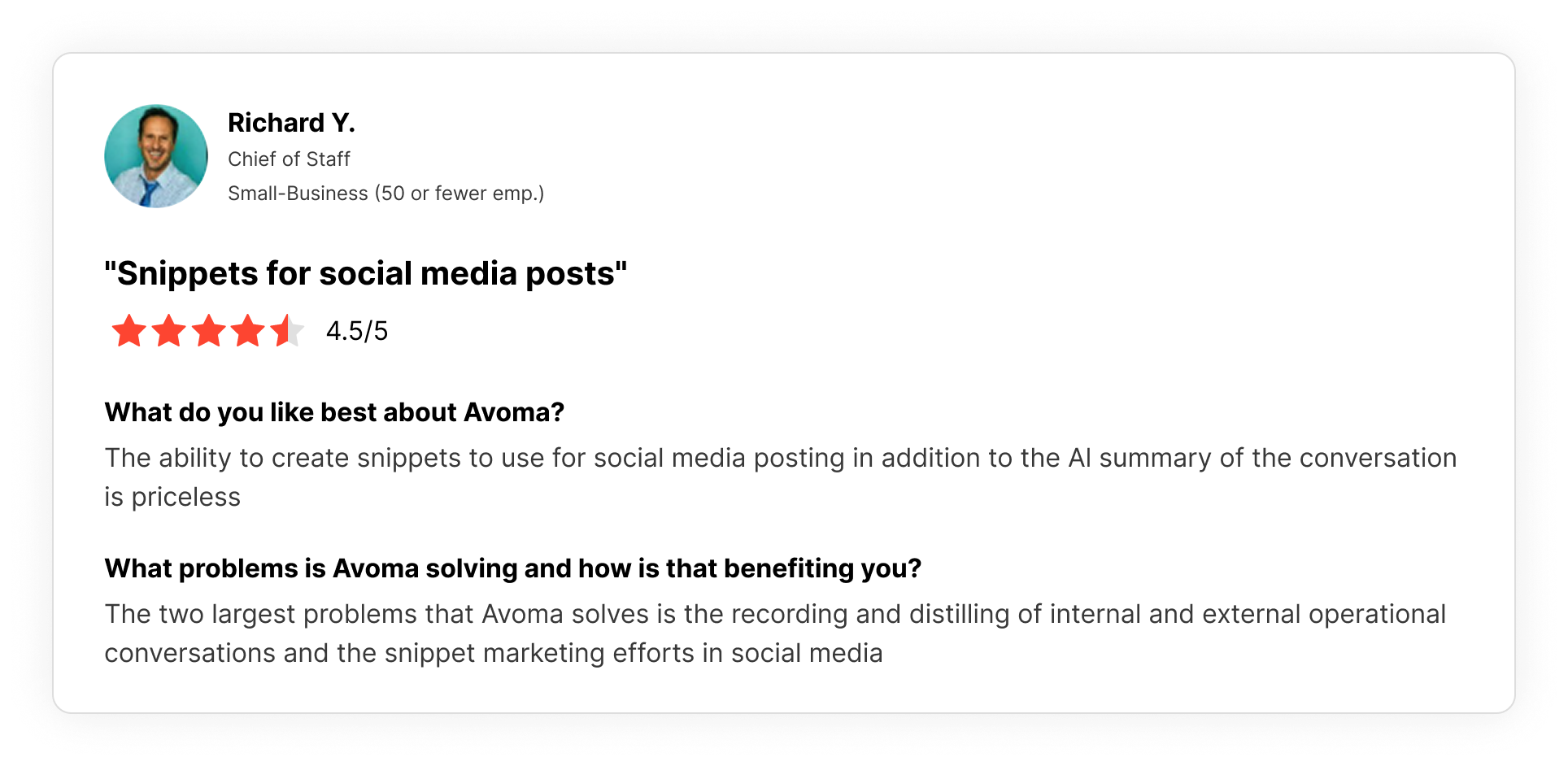
5. Marketing leadership: You can't be in every meeting
You need to know what customers are saying. But you can't join every call. So you rely on team reports and slack messages. Someone's interpretation of what happened. The signal degrades every time it passes through another person.
Story:
Jordan, a VP of Marketing, wanted to ensure marketing was aligned with real buyer needs. By reviewing Avoma’s Conversation Insights Dashboard, Jordan could monitor how customers described challenges, competitors, and ROI expectations – across hundreds of calls without attending them.
Use Cases:
- Strategic Insights: Review Topic Trends and Keyword Analytics to understand what’s changing in the market.
- Team Enablement: Use recorded call snippets to train marketers on messaging and customer language.
- Cross-Functional Alignment: Share insights with Product and Sales to ensure consistent customer storytelling.
ROI:
- 30–40% stronger cross-department alignment.
- Leaders save 5+ hours weekly by not having to attend calls live.
“As a marketer, Avoma has been a great tool beyond just conversation intelligence and helps us align with sales. We've used the search function to create account lists for feature launches/updates, and re-engagement lists based on "follow up in x months" language.” - Olivia, Head of Marketing
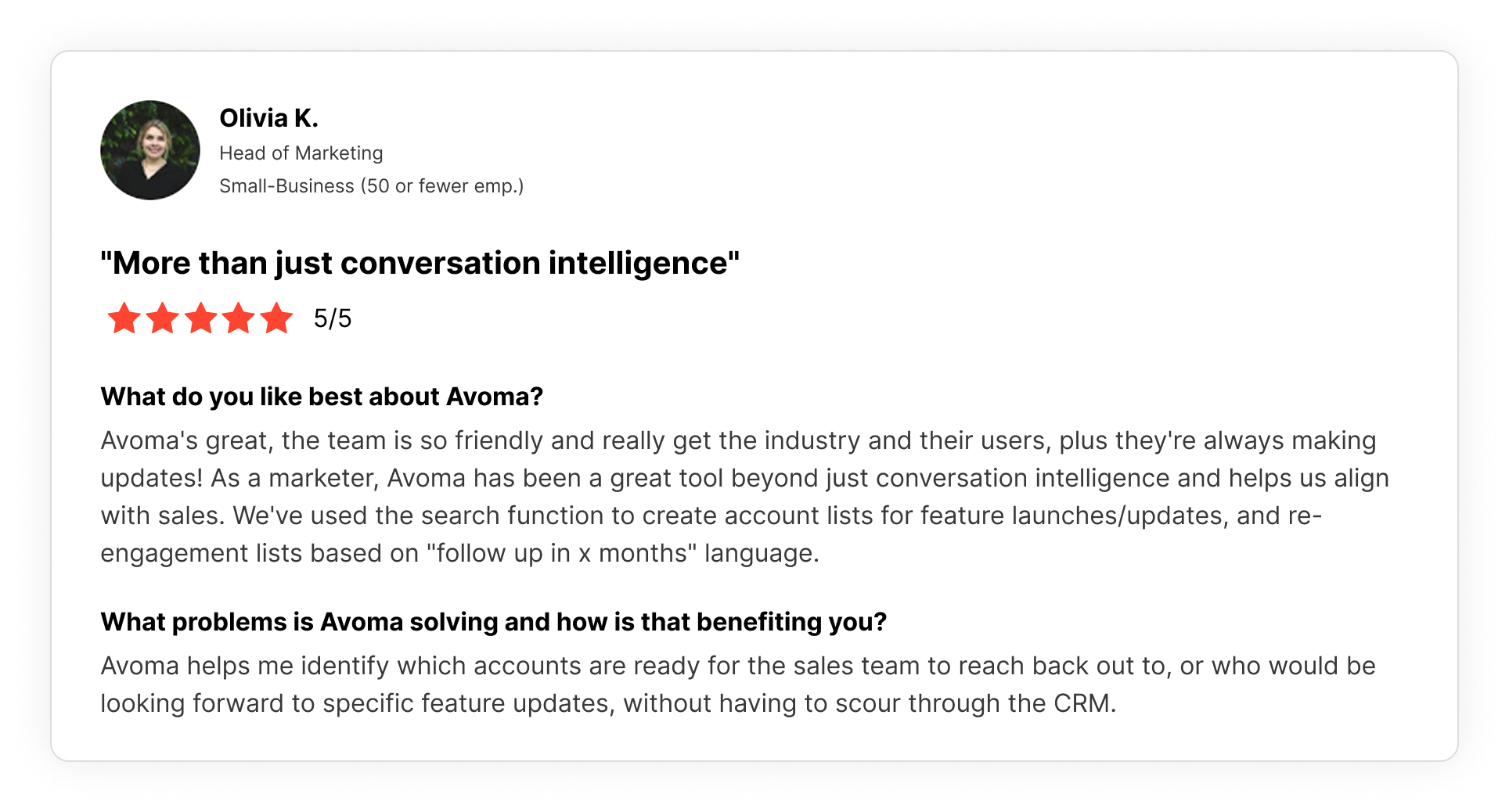
The Avoma conversation intelligence playbook for marketing teams
Discover how marketing teams use Avoma to unite Product, Content, and Demand Gen around the conversations already happening across your business.
Step 1: Automatically capture every customer and team conversation
Enable auto-recording for all customer-facing meetings. Connect Avoma to Zoom, Teams, or Meet so all meetings are automatically recorded, transcribed, and summarized.
Meetings worth capturing:
- Customer and prospect interviews
- Discovery and demo calls
- Win-loss interviews
- Customer success reviews and renewals
- Internal product feedback sessions
- Analyst or partner discussions
“As a Content Marketing Manager, Avoma allows me to re-watch interviews and meetings with company stakeholders to improve my website content pieces... Avoma means I can easily locate the point of the meeting that’s needed and pick out a precise quote in seconds. It has transformed the quality of the content I’ve been able to write.” - Scott W, Content Marketing Manager
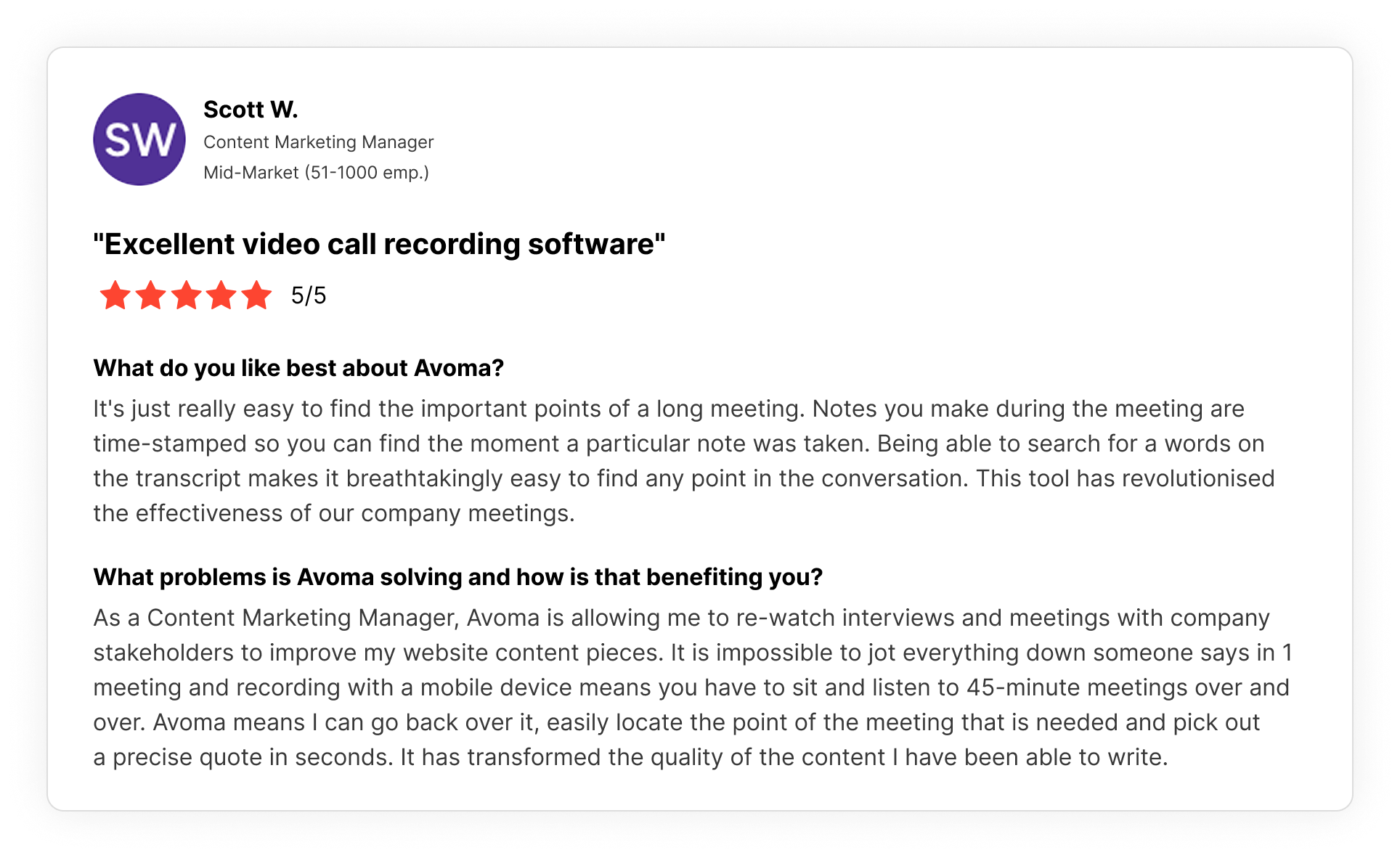
Step 2: Spot themes and trends across all customer conversations
Once your calls are transcribed, Avoma automatically applies Smart Topics, categorizing conversations by themes such as pricing, competitors, pain points, or product requests.
You can also set up Keyword Tracking to monitor specific words or phrases (like “ROI,” “integration,” or “ease of use”) across all conversations.
Why it matters:
- Product Marketers can identify messaging gaps or objections appearing across multiple calls.
- Content teams can track recurring phrases customers use to describe their needs – a goldmine for crafting blogs, ads, social posts, and landing pages.
- Demand Gen and SEO teams can extract emerging terminology that reflects how the market is evolving.
Step 3: Create a library for centralized marketing insights
Create shared playlists of calls or snippets in Avoma:
- Voice of Customer (VoC) – direct feedback from customers and prospects
- Market Trends – recurring topics, pain points, competitor mentions, new tools, and use cases
- Content & Story Ideas – call clips and quotes for social, blog, campaigns
- Product Feedback – input to inform product marketing
Each call or snippet can be tagged, bookmarked, and summarized automatically by Avoma’s AI Notes, ensuring insights are searchable and ready to use later.
Step 4: Share insights seamlessly across teams
Insight is only valuable when it’s shared. Avoma makes collaboration effortless – every snippet, summary, and transcript can be shared, tagged, or discussed right inside the platform.
How teams use it:
- Product marketers share customer quotes with Product and Sales in Slack or Notion
- Content teams embed Avoma clips into editorial briefs
- Leadership uses shared playlists to align messaging across GTM
Start a weekly insights share: Slack channel with interesting moments, 15-minute huddle to review quotes, or monthly playlist.
This cross-functional visibility turns isolated calls into organizational knowledge, reducing dependency on anecdotal feedback or selective reporting.
Step 5: Review insights regularly
Avoma’s Conversation Insights Dashboard aggregates data from all calls to visualize trends over time, giving Marketing leaders a clear view of what the market is saying week over week.
Example metrics include:
- Frequency of competitor mentions
- Volume of pricing or product feedback conversations
- Emerging objections or new keywords in buyer language
- Participation and talk-time analysis for internal enablement sessions
By reviewing these dashboards monthly or quarterly, Marketing leaders can make data-backed decisions about which campaigns to prioritize, what narratives to refine, and which enablement gaps to address.
Step 6: Close the loop between conversations and conversions
The next step is to turn insights into measurable outcomes. Avoma integrates with CRMs, enablement, and collaboration tools (like HubSpot, Salesforce, Clickup, Notion and Slack), allowing you to connect what customers say with how your marketing performs.
Example workflows:
- Link win–loss keywords in Avoma to conversion rate trends in your CRM.
- Identify messaging themes from customer conversations that correlate with higher engagement in campaigns.
- Measure content impact by tracking whether pain points discussed in calls are later addressed in blogs, emails, or ads.
This creates a closed feedback loop – from listening → learning → launching → measuring → refining.
Step 7: Create a habit of listening
The most successful marketing teams using Avoma build a culture of curiosity, where everyone, from CMOs to copywriters, listens to a few customer conversations each week.
You can make this part of your process by:
- Hosting a monthly Voice of Customer Review meeting using Avoma insights.
- Creating a “Best of the Month” snippet playlist showcasing compelling customer stories.
- Rewarding marketers who discover insights that directly influence campaign success.
Over time, Avoma becomes not just a note-taker, but your marketing radar, continuously scanning every customer interaction for insight.
“Avoma is like nothing I've seen before,” Emily says. “As a marketer, it is SO helpful to listen to sales calls, and Avoma makes it easy to get to the parts that make sense without listening to the entire call.”
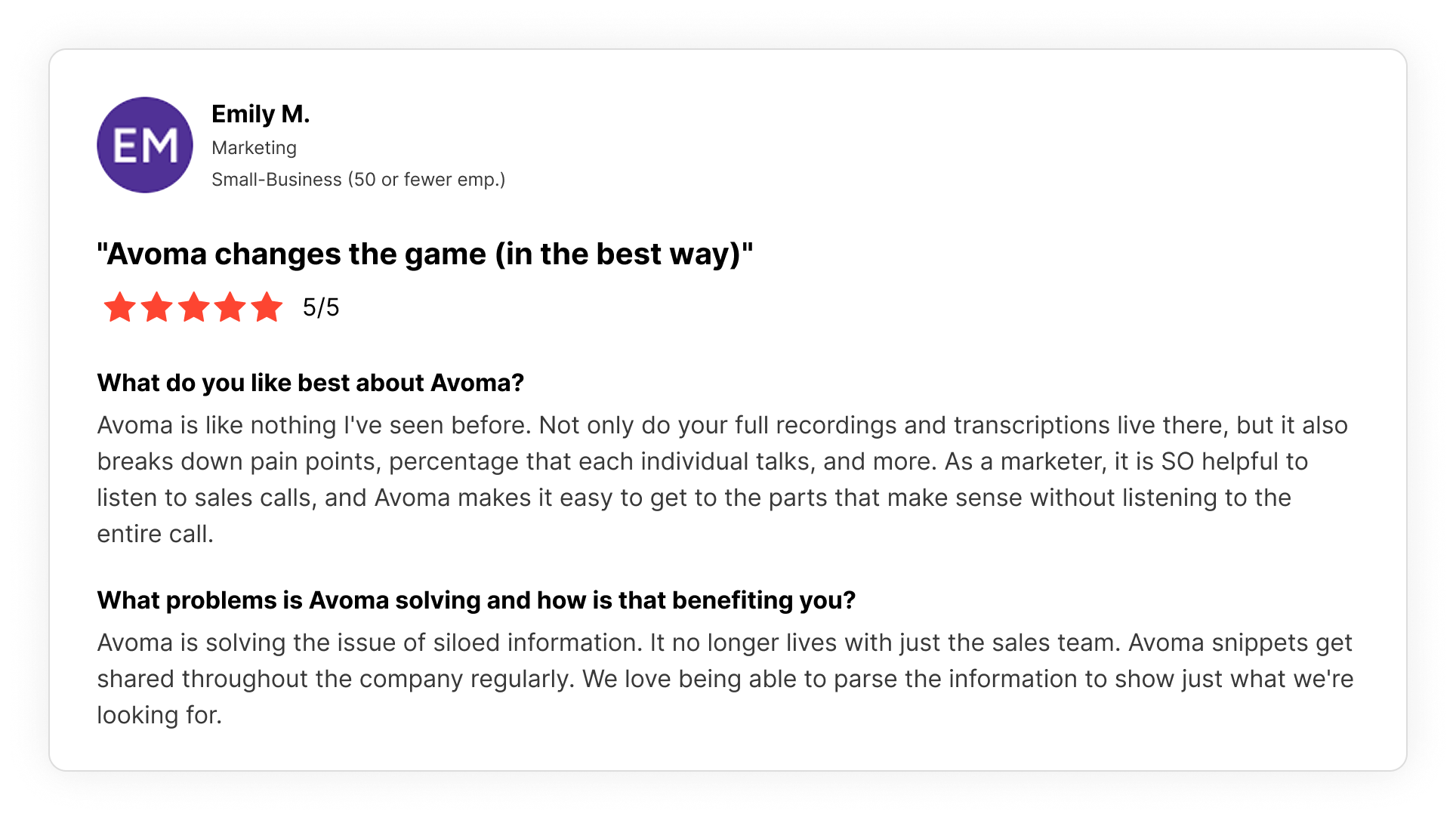
The real ROI
But here's what actually matters: You're not building campaigns based on assumptions and guesswork. You're building them on what customers said this week.
Make your customers your co-writers with Avoma
Every campaign, headline, and message should start with your customer’s voice.
Not from an outdated persona doc from 2024.
Not what your CEO thinks sounds good.
Not what seemed clever in a brainstorm session.
Your marketing team is sitting on hundreds of hours of customer conversations treating them like an archive instead of an intelligence system.
With Avoma, you can capture and surface what customers actually say, think, and feel. You can move faster, stay closer to the market, and out-message everyone else.
The teams who listen will win. Make sure you’re one of them.
Frequently Asked Questions
Conversation intelligence for marketing means capturing and analyzing real customer and prospect conversations—calls, demos, onboarding—to uncover patterns, language, pain points and themes that typical dashboards and surveys miss.
Because traditional data (dashboards, surveys, web analytics) doesn’t always reveal how customers talk about their problems, what objections they raise in demos, or how they describe value in their own words. Conversation intelligence fills that gap.
You can learn recurring customer pain-points, competitor mentions, language prospects use, emerging market trends, objections raised in demos, and see which messaging resonates, what insights you can surface for content, demand gen, product marketing.
By using actual customer language and real objections from conversations, you can craft campaigns, blogs, ads and landing pages that reflect how customers speak — which boosts relevance, engagement, and conversion.
Challenges include integration (connecting calls/meetings), getting teams to use the insights, interpreting sentiment or themes correctly, and ensuring privacy/compliance when dealing with voice or text data.
Measures include content production speed, improved win-loss messaging, increased campaign resonance/CTR, reduced cost per acquisition, better alignment between marketing and sales/product teams. All because you’re acting on richer insight than only surface metrics.






What's stopping you from turning every conversation into actionable insights?



